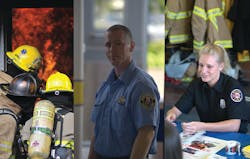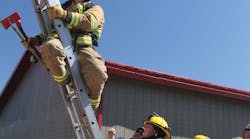The Keizer Fire District (KFD) was established in 1948 as a career/combination department serving a population of 36,000. Situated in the center of the City of Keizer, KFD covers approximately 10 square miles and responds to nearly 4,000 calls annually. We are an advanced life support (ALS) fire-based transporting agency with 23 career personnel and 40 volunteers. Over 80 percent of our emergency response calls are emergency medical Services (EMS) related while less than 2 percent are fire related.
Five miles from the front door of our station is Chemeketa Community College (CCC), a regional vocational training college known across the country for their fire and EMS accredited training and education.
Keizer Fire began building our relationship with Chemeketa five years ago, first as part of a Paramedic Student Intern Program. As time passed, our program grew to include a Student Firefighter program and then a Fire Student Intern Program. As a fire-based transporting emergency response agency Keizer Fire has a lot of experience to offer a paramedic student. Paramedics in Oregon must have a two-year college degree to be certified in the state EMS system. Most paramedic students in Oregon come from Portland, Southern Oregon, or CCC programs. All but two of our paramedics came through the program at Chemeketa. I was surprised when I arrived in Keizer as fire chief in 2008, that we had no relationship with the college right outside our door.
Paramedic Program
We began building our student program in labor management. They are the stakeholders with the most to say about the program and with the most influence in its success. Their main concerns were extra duties to the student preceptors who would monitor, mentor, coach, counsel and ultimately have a major influence on the student's success. In addition, paperwork, direct supervision and oversight of patient care would be required. Each student is supervised by a shift paramedic and acts as the student preceptor. In labor management, it was proposed and agreed by labor that; at the completion of each three month term, the fire district would bill the college for $300 which would be paid directly to the preceptor. For the last five years, three students per term have been prepared as future paramedics with the mission, vision and values of KFD. The benefit to the students is obvious.
The benefit to the college is accredited work experience education credits for their students and validation of the program. Successful students build up the college vocational degree education base. The KFD is benefitted by a three person paramedic unit which enhances staffing. Students bring current information and new trends in EMS while their preceptors gain the experience of mentoring and supervision while being part of a culture of training. Paramedics must constantly train and retrain to stay sharp in the world of EMS. A training facility provides for that culture. In addition, it is important to note that other agencies around our county team up with the college as well.
Student Firefighter Program
Next we decided to build a Student Firefighter program. We met with labor to propose a college tuition/sleeper program in which KFD would pay the college tuition for a qualified volunteer member to go to college and still pull shifts with the district. Our need arose from a shortage of qualified apparatus operators (engineer) personnel in the volunteer ranks and the district would benefit from the shift coverage by a qualified volunteer. The student would benefit from the college tuition in exchange for volunteer shift coverage. We currently have three student firefighters going to school full-time. These student-firefighters pull shifts on evenings and weekends.
In terms of employee man-hours, this equates to a formula of: three students, total amount for tuition is $18,500 per year, which in hours equals, 1 1/2 full-time employees in shift coverage (FTE). Student tuition is paid by the district directly to the college to clarify taxation reimbursement issues and validate this as a true intern program.
New Intern Program
Our most recent addition to the program is a Fire Student Intern Program which rose out of the growth and successes of the college's fire student vocational training program. The fire district signed an Intergovernmental Agreement (IGA) outlining the program with CCC recently. This program is for fire students, like those in our paramedic student program, are in need of locations to complete their on the job training and vocational work experience credits. The college fire student population had grown enough to need more vocational training agencies. Again, we began with our stakeholders in our labor and volunteer personnel ranks. Labor wanted to be assured we would not supplant career positions with student interns. Our agreement with labor did not take much more than a discussion in which KFD agreed it is unsafe to put interns in place of veteran firefighters.
Our staffing on an engine is three personnel. If a fire student intern were assigned to the shift; then the engine would have four personnel. It is important to note that a intern is a second year college student with live fire training experience, certified at the level of an International Fire Service Accreditation Congress (IFSAC) entry level firefighter. They are fully prepared to don an SCBA, pull a pre-connect, and fight fire and they even come with their own personal protective equipment. Our agreement with the volunteer ranks was an assurance we were not going to replace the community volunteer with student firefighters. This was easy to accommodate as we are only talking about three student interns, one on each of our three shift rotations.
The intern program is a win for the college in that it provides another cooperative work experience education program with a professional agency. The student benefits by building a work experience resume from an accredited agency. KFD benefits from the student interns and also receives usage of the college's regional training facility and receives tuition credits in consideration of their shared interest in the college student program. The entire program is a balancing act of education, accreditation, and experience.
While the benefits of partnering with the local community college are paying off, it is important to state what this program is and is not. It is a training program in partnership with our local junior college to benefit students, the college, and in turn benefit the the fire district. It is not a program to supplant career positions or to staff apparatus. It augments the staffing we have to the benefit of each partner, and provides some consideration back to the district as a community partner.
The KFD has had a fire explorer program for decades and Explorer Post #350 is part of the Boy Scouts of America curriculum. Explorer programs are designed to allow for boys and girls ages 14-18 years a healthy place to gain early learning and career perspective in whichever vocation they choose. Our curriculum provides for training in first aid, CPR, ropes and knots, emergency preparedness, citizenship, organization skills, goal setting, and more. What is really exciting is that now a 14-year-old, junior high school student can join our Explorer program, complete high school, then at age 18, join our volunteer firefighter ranks as a recruit, earn tuition credit, and graduate as a firefighter with a two-year degree, or a paramedic with a firefighter degree in three years.
Building future firefighters and paramedics from teens to career veterans is an exciting legacy we can be proud of.
JEFF COWAN is the fire chief of the Keizer, Ore., Fire District. He has college degrees in fire service management and administration, fire science, and is a certified NREMT/Paramedic. This is his 32nd year in public emergency service. He can be reached at www.keizerfire.com.







